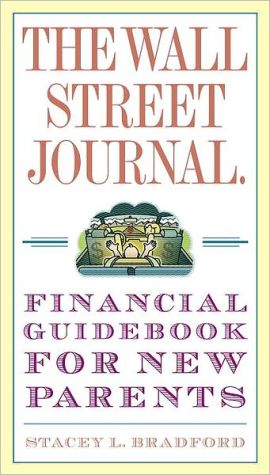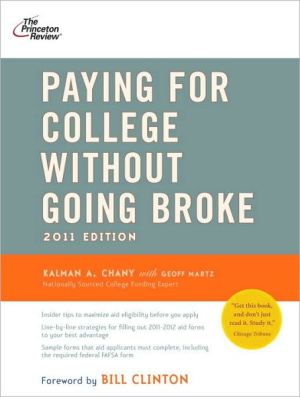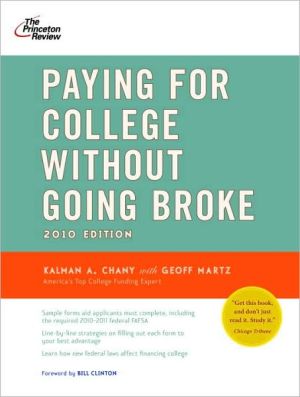The Wall Street Journal. Financial Guidebook for New Parents
Bringing home your bouncing baby boy or girl should be an exciting time of celebration-not cause for worry about how you're going to pay for feeding, clothing, and caring for your new bundle of expenses. The average family will spend between $11,000 and $16,000 during a new baby's first year, and more than $200,000 before a kid's eighteenth birthday. Unfortunately, a second child only doubles your costs, with little economy of scale for each additional baby.\ Before you start using these...
Search in google:
A practical approach to affording your kids from cradle to college.Bringing home your bouncing baby boy or girl should be an exciting time of celebration–not cause for worry about how you’re going to pay for feeding, clothing, and caring for your new bundle of expenses. The average family will spend between $11,000 and $16,000 during a new baby’s first year, and more than $200,000 before a kid’s eighteenth birthday. Unfortunately, a second child only doubles your costs, with little economy of scale for each additional baby. Before you start using these statistics as birth control, take a deep breath and know that you can have a family and make a comfortable future for your children while saving for your own important goals. The Wall Street Journal Financial Guidebook for New Parents shows you the way, with information on how to: • Safeguard your child’s well-being with wills, trusts, and life insurance• Best weigh your child-care options and decide whether to go back to work• Save on taxes with child-friendly tax credits and deductions plus tax-advantaged benefits at work• Manage your family’s health-care costs• Save for long-term costs by setting up a college fund• Spend smart and save money at every stage of your child’s development• Continue to contribute to your own retirement savingsFrom maternity (and paternity) leave to flexible spending accounts to 529 college plans, The Wall Street Journal Financial Guidebook for New Parents provides all the information you need to meet your child’s expenses while also protecting your family’s financial security. Tracy Mohaidheen - Library Journal Bradford, an associate editor at SmartMoney.com, presents a relevant and witty overview of the awesome task facing new parents—affording their kids. She covers all the major issues, including child tax credits, the Family and Medical Leave Act of 1993, flexible spending accounts, and 529 plans; even wills, trusts, and disability insurance are considered. Bradford writes from a female perspective, and humor abounds: "Along with hemorrhoids and hormonal mood swings, meager maternity benefits are just one more harsh reality that no one warns pregnant women about." Considering the enormous and long-term expense of a new bundle of joy, her money-saving tips are sure to be popular. Bradford clearly grasps the mindset of new parents and keeps information complete but concise; the chapters on health care and college savings plans are so succinct that it would be nearly impossible not to understand them. Only the chapter "Where Should You Nest?" disappoints, as it is not broad enough to serve most readers. VERDICT Bradford's book offers a more comprehensive framework than Steve and Annette Economides's America's Cheapest Family Gets You Right on the Money. Here's one work that all new and prospective parents worried about finances should consider.—Tracy Mohaidheen, M.L.I.S., West Bloomfield, MI
The Wall Street Journal. Financial Guidebook for New Parents\ \ By Stacey L. Bradford \ Three Rivers Press\ Copyright © 2009 Stacey L. Bradford\ All right reserved.\ ISBN: 9780307407078 \ \ \ Chapter 1\ \ Your Maternity (or Paternity) Leave\ \ Common Misconception:\ \ Maternity (or paternity) benefits are so generous that I can easily afford to take at least three months off to bond with my baby.\ \ The Reality:\ \ Most mothers receive a measly six to eight weeks of disability payments, making maternity leave a financial strain during an already stressful time.\ \ The Bottom Line:\ \ It’s up to you alone to make your maternity leave possible. Plan ahead and start building a reserve fund to help you afford all the time off that your employer allows.\ \ Congratulations, you’re pregnant!\ \ Now brace yourself for some unwelcome news. Along with hemorrhoids and hormonal mood swings, meager maternity benefits are just one more harsh reality that no one warns pregnant women about.\ \ Once you officially announce your good news to your boss, you’ll quickly figure out that your time off with the baby could put a serious strain on your finances. Don’t kid yourself—\ \ maternity leave is no paid vacation. While most companies try to paint themselves as “family-?friendly,” the reality is that most employers provide only the bare minimum in terms of benefits required by law. That meansthat if you work for a large company, you may get only twelve weeks of unpaid leave. If you’re employed by a small firm, you may not get even that.\ \ Even so, don’t panic. The truth is that maternity leave is only the first of many financial challenges that will come your way as new parents. But along with learning how to change\ \ diapers and swaddle a newborn, you can master managing your money at this more complicated stage of your life, too. In this chapter I’ll provide you with all of the information and tools you need to get through your maternity leave with your finances intact.\ \ Get an Early Start\ \ The best way to budget for your maternity leave is to start saving while you’re still pregnant. With some careful planning and a bit of discipline, you should be able to afford to take as much time to bond with your baby as your employer allows. Let’s take a closer look at how one couple, Jennifer and Steven Share, managed to do it.\ \ When Jennifer was pregnant with her first child, she worked as a CPA for a small accounting firm in New Jersey. Her employer was generous and offered all of its female employees six months of maternity leave. Although the time off was unpaid, Jennifer managed to take full advantage of this benefit and bond with her baby without derailing the family’s finances.\ \ What was her secret? Before Jennifer got pregnant she found out how much time her company would allow her to spend with a baby. She then started setting aside a little money each month in a reserve fund to help pay bills once the couple lost her paycheck during maternity leave.\ \ But soon after Jennifer conceived that plan hit a snag. Steven lost his job and the couple felt what it was like to live on just one salary a lot sooner than they had planned. “I was in panic mode,” Jennifer says. At that point the Shares realized that they needed a safety net that was large enough to carry them should they both be out of work at the same time.\ \ A couple of months later, Steven found a new job and Jennifer started saving much more aggressively. “I wanted to bank six months of mortgage payments,” she says. Fortunately for the Shares, Jennifer reached her savings goal a little early; a difficult pregnancy forced her to stop working six weeks before her due date and put her on disability.\ \ Looking back, Jennifer admits it was tough to cut back their spending before her daughter was born. But once she arrived, Jennifer and Steven knew the sacrifice was worth it. There’s nothing Jennifer would have traded in exchange for those precious six months with her baby girl.\ \ No matter what you do, don’t let your maternity leave set you up for a financial setback later on. While it may be tempting to live off your credit cards for a little while, the reality is that your expenses will only increase once a baby arrives, making it more difficult to chip away at the debt over time.\ \ How Much Time You’ll Get to Spend with Baby\ \ Under the Family and Medical Leave Act of 1993 (FMLA), public agencies and employers with at least fifty employees are only required to give new parents twelve weeks of unpaid leave. Some states, however, have passed similar laws that may apply to women who aren’t given time off under the federal law. (Contact your state’s Department of Labor to figure out how much time your employer is required to provide for maternity leave.) Your firm, like Jennifer Share’s, may also opt to provide you with a longer maternity leave.\ \ Now for the bad news. If you’re like the 45 percent of workers who receive a paycheck from a small company with fewer than fifty employees, you won’t fall under the protection of the FMLA. That means you aren’t entitled to twelve weeks off to recover from the birth itself and bond with your baby. But if your company has at least fifteen employees, your boss must offer you the same insurance and any other support it provides other workers with medical or disability leave under the Pregnancy Discrimination Act.\ \ How Much Money You Can Expect During Your Leave\ \ The most important question most families have is how much Mom will get paid during her maternity leave. Unfortunately, the federal law ? doesn’t require employers to pay you anything during your time off. Many companies, however, do have short-?term disability insurance for their employees. If that’s the case, you can probably count on six weeks of disability for a vaginal delivery or eight weeks for a cesarean, plus any accrued vacation you’ve already earned. In some cases you may also be able to tap into your sick days.\ \ Sounds pretty good, right? Before you decide to skip this chapter thinking you won’t need to save any money before the baby arrives, realize that there’s a slim chance disability pay will mirror your regular paycheck. That’s because most disability payments are capped at between 50 percent and 60 percent of your salary.\ \ If you’re adopting or fostering a child, you won’t see any disability checks or sick leave.\ \ So what will this mean for your budget? Let’s say you get six weeks of disability payments, at\ \ 50 percent of your regular salary, and two weeks of paid vacation. That works out to the equivalent of a full paycheck for just five weeks. If you get three months off, you’ll have to find a way to cover your expenses for the next seven weeks without Mom’s income.\ \ Contact your human resources department to find out exactly how much money you’ll pull in during your leave and to get all the paperwork needed to apply for disability benefits. Your employer cannot fill out the forms on your behalf.\ \ Saving for Your Maternity Leave\ \ My very generous employer allowed six months off for maternity leave, and I fortunately did not have to worry about money during the first two months. That’s because money was still coming in the door thanks to my disability insurance and\ \ vacation—but I still had four months without any income that I needed to plan for.\ \ Looking back, it was relatively easy to stash away at least part of the money we needed without even trying. While I was pregnant, I followed my doctor’s orders and skipped drinks with colleagues after work. On the weekends, I was simply too tired to socialize as much as I used to. And once our daughter arrived, our social calendar came to a standstill. We didn’t go out to eat or spend any money on entertainment for at least four months, other than the occasional Chinese takeout and Netflix DVDs.\ \ Still, social hibernation alone probably won’t save you enough to entirely make up for that lost paycheck. You’ll need to be more proactive and somehow find ways to save money and set it aside for when the baby arrives. Saving for maternity leave is also just the beginning, and many of the steps you take now to afford the time off will also pay off after your baby is born. If you’re having trouble figuring out how to save enough for maternity leave, maybe you need to take more drastic measures that will enable you to better afford your new bundle of joy once she arrives.\ \ Remember the Shares? The first time around they managed to slash their budget by cutting back on frivolous shopping and entertainment. A few years later, when Jennifer was about to give birth to their third and fourth children (twin girls), they realized they needed to find more extreme ways to afford the cost of raising four kids. They decided to sell their house near the New Jersey shore and move to a cheaper neighborhood, decreasing their mortgage payment by $400 a month. They also bought a less expensive SUV, lowering their car payment by $60 a month.\ \ There are literally hundreds of ways to save money. Here are just a few tips to help you get started and build up a reserve fund before your maternity leave. (See the full “Money-?Saving Tips for Every Stage” guide at the end of the book for more ideas on how to cut back your child-?related expenses.)\ \ Save More\ \ •Consolidate your debt. Don’t waste money on high-interest-rate credit cards. Instead, transfer your balances to a zero-percent or low-interest-rate card and then aggressively work toward paying off what you owe. This will help free up cash flow both during maternity leave and after baby arrives.\ \ •Cut back on eating out. You can easily slash your spending by doing some simple things like bringing your lunch to work (if you save $3 a day, that will total $60 a month) or drinking the office decaf instead of splurging on a $3.50 cup of joe from Starbucks ($70 a month).\ \ •Downsize your entertainment costs. Skip your weekly trip to the movie theater and rent a DVD instead and you can save up to $70 a month. When that’s not enough, get creative and consider inviting friends over for game night rather than dining out at an expensive restaurant.\ \ •Audit your utilities and other household bills. While nesting, make a list of household services, such as premium cable channels, that you’re not using and cancel them. Consider dropping your landline and relying solely on your cell phone. If you want to keep your home phone, check out consumer Web sites such as LowerMyBills.com or MyRatePlan. com to see if there is a better service plan for you. You can even save hundreds a year by reducing your energy costs if you seal leaky windows and use Energy Star appliances.\ \ Spend Less\ \ •Avoid the urge to upgrade. Just because a baby is on the way doesn’t mean you need to sell a reliable (and affordable) car and get a new SUV. As long as you have a backseat with room for an infant seat, you’re set.\ \ •Hold off on the McMansion. There’s no reason to rush moving into a larger and more costly home. Provided there’s room in your current house for a crib, you should be fine. It’s better to wait until you’ve figured out what your future finances will look like before you start increasing your financial commitments. One of the biggest dangers is that you could buy a new house based on two paychecks only to realize later that one of you wants to stay home with the baby.\ \ •»Register for as much as possible. A common error expectant parents make is spending hundreds of dollars on baby items before the birth only to be inundated with gifts at a shower or after the little one’s arrival. Instead, register for the items you need, and wait and see what you get.\ \ •Borrow from friends. So much baby gear, including infant swings and bouncy seats, has a limited shelf life. If you only plan to use an item for a few months, try to borrow one from a friend. Not only do most parents want to help out, but they also realize that lending gear is a great way to get rid of large plastic objects until they have their next kid.\ \ What Happens After Maternity Leave?\ \ Once your maternity leave is up, you’ll have to decide whether to go back to work or stay home with the baby. Most women who plan to return to the workforce simply go back after their official leave is up. However, that’s not what happened to Lia Gravier.\ \ After taking three months off to care for her baby, Lia was ready to return to her job as the public relations manager at a New York City– based museum. Three days before she was scheduled to go back to work, her boss called her at home. The director of the museum told her he had given her management position to someone else and that she could come back as a colleague’s assistant.\ \ Lia says she never saw the demotion coming. She had been in touch with her coworkers during her maternity leave and her boss never gave her any indication that her job was at risk. She was so taken aback by the phone call that she didn’t initially know how to respond. She also wasn’t entirely clear on what her rights were under the FMLA. After speaking with a lawyer, Lia learned that the FMLA guarantees that you can’t be demoted while out on maternity leave; your employer must either hold your position for you or provide you one with equivalent benefits, pay, working conditions and seniority.\ \ Although Lia initially considered filing a complaint against the museum, she later decided not to follow through. “You’ve just had this amazing thing happen in your life. Why turn it into something negative?” Lia quickly found a new job in a more family-friendly environment. She even managed to find a position where she could work part-time.\ \ In the next two chapters, I’ll help you decide what to do after your maternity leave and discuss how your decision will affect your family financially over both the short term and the long haul. The good news is that having a financial game plan in place before your maternity leave starts you off on the right financial foot, so you should be able to afford to raise your kids however you want, whether that’s as a stay-at-home parent or as one who works in an office. \ \ Continues... \ \ \ \ Excerpted from The Wall Street Journal. Financial Guidebook for New Parents by Stacey L. Bradford Copyright © 2009 by Stacey L. Bradford. Excerpted by permission.\ All rights reserved. No part of this excerpt may be reproduced or reprinted without permission in writing from the publisher.\ Excerpts are provided by Dial-A-Book Inc. solely for the personal use of visitors to this web site. \ \
Introduction Now the Fun Begins 1Part One When Baby Makes ThreeChapter 1 Your Maternity (or Paternity) Leave 9Chapter 2 Kissing That Cubicle Good-Bye 20Chapter 3 Returning to the Grind 33Chapter 4 Who Says Uncle Sam Doesn't Care? 43Chapter 5 Where Should You Nest? 55Part Two No One Ever Said Kids Were CheapChapter 6 Finding (And Paying for) Mary Poppins 75Chapter 7 Avoiding A Health Scare 93Chapter 8 Paying for Harvard 107Part Three Your Contingency PlanChapter 9 Yes, You Need A Will 125Chapter 10 Trusts: They Aren't Just for the Wealthy 138Chapter 11 Life Insurance: Better Safe Than Sorry 148Chapter 12 Accidents Happen ... Are You Prepared? 161Money-Saving Tips for Every Stage 170Appendix 183Acknowledgments 187Index 189
\ Library JournalBradford, an associate editor at SmartMoney.com, presents a relevant and witty overview of the awesome task facing new parents—affording their kids. She covers all the major issues, including child tax credits, the Family and Medical Leave Act of 1993, flexible spending accounts, and 529 plans; even wills, trusts, and disability insurance are considered. Bradford writes from a female perspective, and humor abounds: "Along with hemorrhoids and hormonal mood swings, meager maternity benefits are just one more harsh reality that no one warns pregnant women about." Considering the enormous and long-term expense of a new bundle of joy, her money-saving tips are sure to be popular. Bradford clearly grasps the mindset of new parents and keeps information complete but concise; the chapters on health care and college savings plans are so succinct that it would be nearly impossible not to understand them. Only the chapter "Where Should You Nest?" disappoints, as it is not broad enough to serve most readers. VERDICT Bradford's book offers a more comprehensive framework than Steve and Annette Economides's America's Cheapest Family Gets You Right on the Money. Here's one work that all new and prospective parents worried about finances should consider.—Tracy Mohaidheen, M.L.I.S., West Bloomfield, MI —Tracy Mohaidheen\ \








